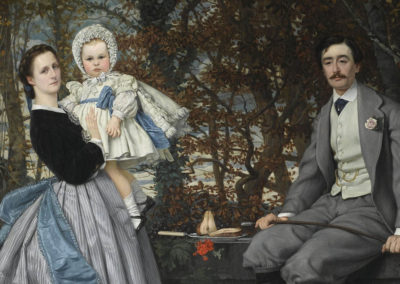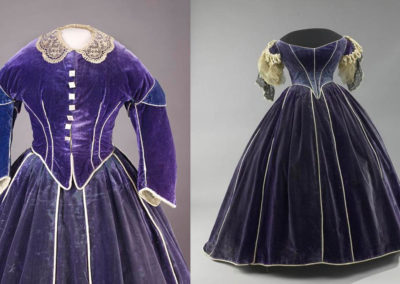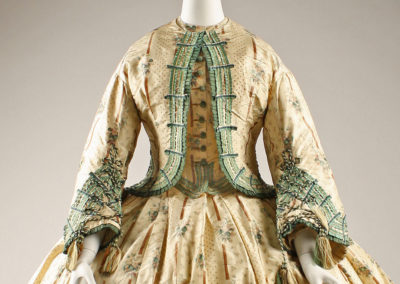OVERVIEW
In 1866 belted dresses became quite fashionable—replacing the pointed bodices previously en vogue. Ribbon trimmings were preferred to artificial flowers.
Womenswear
A
lfred Stevens’ La Dame en Rose (Fig. 1) shows a woman wearing a fashionable dress of the time. The garment has elaborate tiered lace trimmings on the skirts, collar, sleeves, and shoulder seams. It also has a ceinture at the waist to accentuate the wearer’s figure, rounded shoulders, and a slight train. The fabric is a light pale pink and while there are no bright ribbons to offset the pale fabric, the garment can still be described as fashionable. The wearer is showing her stylishness by choosing a select number of trends to wear rather than putting them all on her dress at once.
Several changes in the popular style of dress for 1866 are noted in the January issue of The World of Fashion. First it points to the adoption of round waists with a ceinture, or belt–a shift from the previously popular pointed waist lines. Another notable change is the abandonment of flowers used as trimmings in ball dresses, which are now used scantily, if at all (Fig. 6). Instead fashionable women of the time turned to “ribbons in bands, in bows, and in rûches, and lace both black and white,” to adorn their evening gowns (4).
Fig. 1 - Alfred Stevens (Belgian, 1823-1906). The Lady in Pink, 1866. Oil on canvas; 87 x 57 cm. Brussels: Royal Museums of Fine Arts of Belgium, 1793. Purchased 1866. Source: Royal Museums of Fine Arts of Belgium
Fig. 2 - Claude Monet (French, 1840-1926). Women in the Garden, 1866. Oil on canvas; 255 x 205 cm. Paris: Musée d'Orsay, RF 2773, LUX 1360. Source: Musée d'Orsay
Fig. 3 - Claude Monet (French, 1840-1926). Camille, or The Woman in the Green dress, 1866. Oil on canvas; 231 x 150 cm (90.9 × 59.4 in). Bremen: Kunsthalle Bremen, 298-1906/1. Source: Wikimedia
Fig. 4 - Designer unknown. Dress with Green and Black Stripes, 1866. Silk and velvet trim. Private Collection. Source: Extant Gowns
Fig. 5 - Artist unknown. La Mode Illustrée, vol. 7, no. 42 (October 1866). Source: Google Books
A
nother popular style are dresses with double skirts; the under skirt is commonly made out of silk due to the fabric’s lightness and breathability. The sleeves of these dresses are cut straight with ornamentation on the shoulders and wrists, the seams do not sit directly on the shoulders but slope slightly off the shoulder to create a rounded silhouette (Fig. 4).
It should be noted that by the end of the year crinolines had gradually been removed from fashion. The November issue of The World of Fashion noted:
“The tendency is, gradually to reduce the size both in length and width, and in consequence the crinoline or steel jupon, can at last be discontinued… For the width: skirts are always gored, so as the be without fullness at the front and sides, and many are even made without fullness at the back; others have large plaits at this part, especially those skirts that are made with trains.” (1)
The most popular piece of outer wear is the paletot. This jacket is military-inspired, fitted at the waist and flairs out to follow the shape of the dress, it is often cropped mid-thigh (Fig. 3). The November issue of Peterson’s Magazine notes:
“Paletots are worn in velvet, cloth, and plush; the latter is the most fashionable, and admit of but little trimming. Velvets are embroidered with silk and beads. The leaders of the fashions are trying very hard to introduce colored velvet cloaks.” (362)
Fig. 6 - Designer unknown. Day dress, 1866. Kyoto: The Kyoto Costume Institute, AC4324 82-17-43AE. Source: The Kyoto Costume Institute
Fig. 7 - André-Adolphe-Eugène Disdéri (French, 1819-1899). Princess Alexandra of Denmark, ca. 1866. Photograph. Private Collection. Source: Pinterest
Fig. 8 - Artist unknown. La Mode Illustrée, vol. 7, no. 33 (August 1866). Source: Google Books
Fig. 9 - Artist unknown. The World of Fashion, vol. 42, no. 507 (March 1866). Source: Google Books
Fig. 10 - Charles Frederick Worth (English, 1825-1895). Orange Evening Gown with White Embroidery, 1864-66. Silk faille. Kent State University Museum, 1983.001.1058 a-c. Silverman/Rodgers Collection. Source: Kent State
Fig. 11 - Photographer unknown. Tsaritsa Maria Feodorovna of Russia in Engagement Jewels, ca. 1866. Source: Pinterest
T
hese evening dresses are constructed out of satin or silk, usually a combination of white with pale blue, yellow, pink, or pastel green. It is the most common to see them without sleeves and with an off-the-shoulder cut (Fig. 7). The gowns are distinguishable in this period due to their intricate design work and ornamentation. Popular design elements include ruching, gathering, appliqués, and embroidery. The volume in the skirt is slightly concentrated in the back. The London and Paris Ladies’ Magazine of Fashion observes in its May 1866 issue:
“Crinolines in moderation continue firmly to withstand the attempts made to discard them; in fact, there is nothing perfect for giving an amplitude which is absolutely necessary to a handsome dress, leaving out the fact that it’s the cheapest substitute for an endless number of stiffened petticoats, whose brilliancy is likely to become dimmed by any passing shower.” (51)
As the year progressed The World of Fashion noted in April a new design, the Princess Robe growing in popularity, this is characterized by the lack of a seam at the waist with less fullness in the hip area but stayed consistent with the presence of a train and full back (4).
For promenade wear the upper skirts of the women’s dresses are looped up with cords to show the petticoats; due to their exposure the petticoats are made using the same fabric or a complementary fabric as the upper skirts. The dresses are typically blue, gray, pink, white, or black though most vibrant colors are considered novel. The dresses are trimmed with complementary ribbons and lace. The most common print is stripes, followed by plaid. In May 1866, The World of Fashion notes that the length of the skirts are cut to display the boots worn underneath (4).
Fig. 12 - Madame Olympe (American, born France). Evening Gown, ca. 1866. Silk, glass, synthetic. Los Angeles: FIDM Museum, 2007.893.1AB. Gift of Cathy Gordon. Source: FIDM Museum
Menswear
[To come…]
Fig. 1 - Artist unknown. Gazette of Fashion, vol. 20, no. 237 (Jan 1, 1866). Source: Google Books
Fig. 2 - Nadar (French, 1820-1910). Dr. Samuel Jean de Pozzi, 1866. Photograph. Private Collection. Source: MarcelProust
Fig. 3 - Artist unknown. Gazette of Fashion, vol. 20, no. 239 (March 1, 1866). Source: Google Books
Fig. 4 - Artist unknown. Gazette of Fashion, volume 21 Issue 241 (May 1, 1866). Private Collection. Source: Google Books
CHILDREN’S WEAR
Fig. 1 - André Adolfe Eugène Disdéri (French, 1819-1889). Princess Beatrice, November 1866 [in Portraits of Royal Children Vol.10 1866-67], November 1866. Carbon print; 8.5 x 5.5 cm. London: The Royal Collection Trust, RCIN 2901574. Source: The Royal Collection Trust
Fig. 2 - Sir John Everett Millais (British, 1829-1896). The Minuet, 1866. Watercolor; 10 x 25.5 cm (3 15/16 x 10 1/16 in). Los Angeles: Bonhams. Source: Bonhams
Fig. 3 - Artist unknown. The World of Fashion, vol. 42, no. 507 (March 1866). Source: Google Books
Fig. 4 - Artist unknown. The Ladies Gazette of Fashion, October 1866. Source: Google Books
References:
- “Central Europe and Low Countries, 1800–1900 A.D. | Chronology | Heilbrunn Timeline of Art History | The Metropolitan Museum of Art.” Accessed August 3, 2018. https://www.metmuseum.org/toah/ht/10/euwc.html.
- “Fashions for November.” Peterson’s Magazine 50 (November 1866): 362. https://babel.hathitrust.org/cgi/pt?id=inu.32000000716060;view=1up;seq=368.
- “France, 1800–1900 A.D. | Chronology | Heilbrunn Timeline of Art History | The Metropolitan Museum of Art.” Accessed August 3, 2018. https://www.metmuseum.org/toah/ht/10/euwf.html.
- “From Our French Correspondent.” London and Paris Ladies’ Magazine of Fashion 39, no. 435 (May 1866): 51–53. https://play.google.com/books/reader?id=4iEGAAAAQAAJ&printsec=frontcover&output=reader&hl=en&pg=GBS.PA51.
- “Observations of London and Parisian Fashions.” The Ladies’ Monthly Magazine, The World of Fashion 43, no. 515 (November 1866): 1. https://play.google.com/books/reader?id=SSQGAAAAQAAJ&printsec=frontcover&output=reader&hl=en&pg=GBS.PP94.
- “Observations of London and Parisian Fashions for April, 1866.” The Ladies’ Monthly Magazine, The World of Fashion 42, no. 508 (April 1866): 4. https://play.google.com/books/reader?id=SSQGAAAAQAAJ&printsec=frontcover&output=reader&hl=en&pg=GBS.PP76.
- “Observations of London and Parisian Fashions for January, 1866.” The Ladies’ Monthly Magazine, The World of Fashion 42, no. 505 (January 1866): 4. https://play.google.com/books/reader?id=SSQGAAAAQAAJ&printsec=frontcover&output=reader&hl=en&pg=GBS.PP22.
- “Observations of London and Parisian Fashions for May, 1866.” The Ladies’ Monthly Magazine, The World of Fashion 42, no. 509 (May 1866): 4. https://play.google.com/books/reader?id=SSQGAAAAQAAJ&printsec=frontcover&output=reader&hl=en&pg=GBS.PP94.
Historical Context
Wikipedia: 1866
Rulers:
- America
- President Andrew Johnson (1865-69)
- England: Queen Victoria (1837-1901)
- France
- Emperor Napoleon III (1852-70)
- Spain
- Queen Isabel II (1833-68)
Europe 1866. Source: Omniatlas
Events:
- The Austro-Prussian war begins (June 14)
- The Austro-Prussian war ends with the signing of the Treaty of Prague. (August 23)
- Austria is separated from Germany and is reorganized as the Austro-Hungarian Empire after the Austro-Prussian War. (The Met)
- “Jules Chéret (1836–1932) popularizes a technique of color lithography that marks the rise of the modern advertising poster.” (The Met)
Primary/Period Sources
Resources for Fashion History Research
To discover primary/period sources, explore the categories below.
Have a primary source to suggest? Or a newly digitized periodical/book to announce? Contact us!
Fashion Plate Collections (Digitized)
- Costume Institute Fashion Plate collection
- Casey Fashion Plates (LA Public Library) - search for the year that interests you
- New York Public Library:
NYC-Area Special Collections of Fashion Periodicals/Plates
- FIT Special Collections (to make an appointment, click here)
- Englishwoman's Domestic Magazine (London: 1852-79), 1860-64, 1867-69 (TT500 .E6)
- Costume Institute/Watson Library @ the Met (register here)
- New York Public Library
- Brooklyn Museum Library (email for access)
Womenswear Periodicals (Digitized)
Etiquette Books (Digitized)
Menswear Periodicals / Etiquette Books (Digitized)
Secondary Sources
Also see the 19th-century overview page for more research sources... or browse our Zotero library.


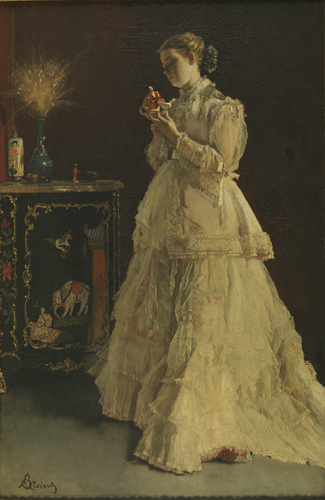







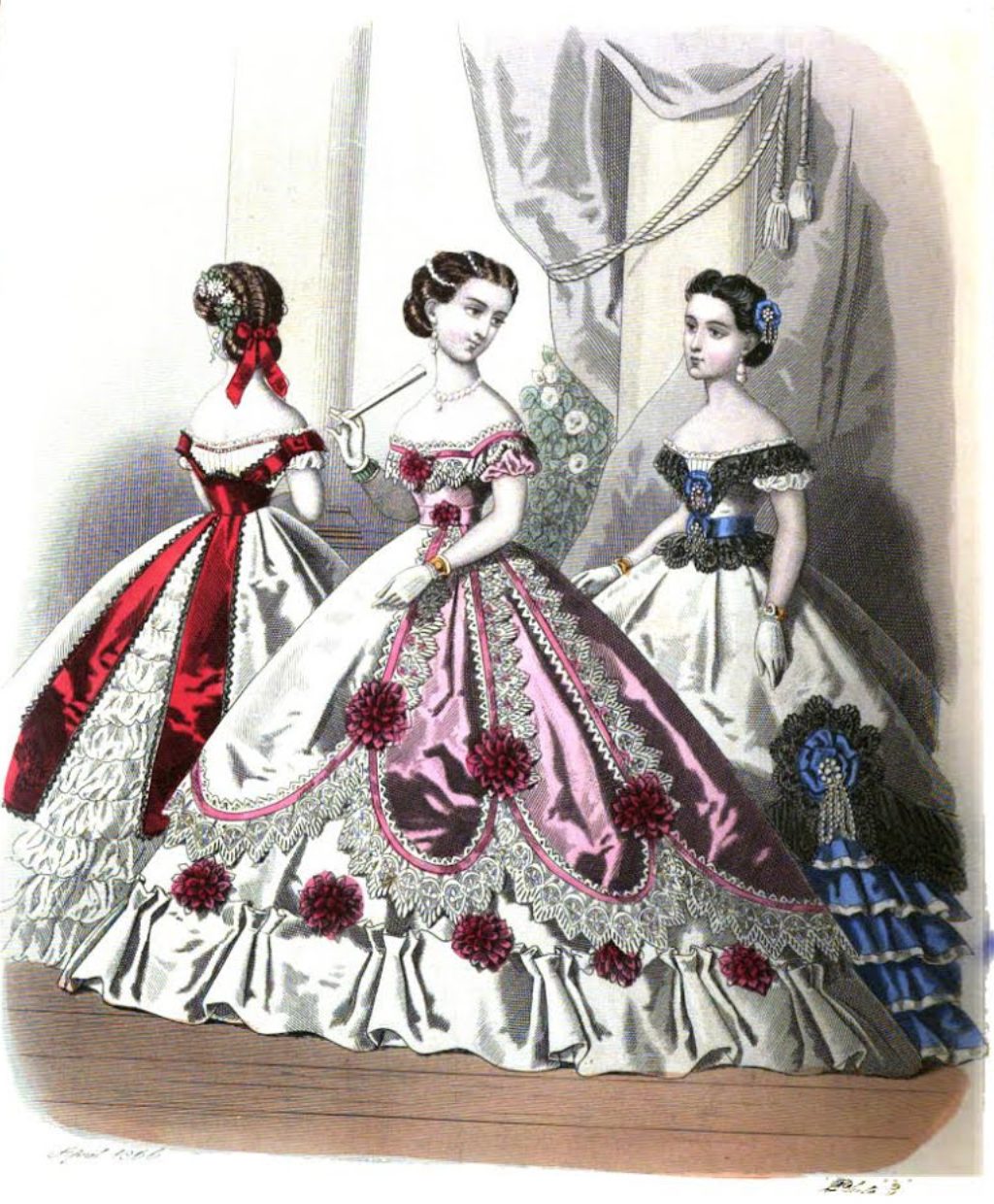







![Princess Beatrice, November 1866 [in Portraits of Royal Children Vol.10 1866-67] Princess Beatrice, November 1866 [in Portraits of Royal Children Vol.10 1866-67]](https://fashionhistory.fitnyc.edu/wp-content/uploads/2017/09/1866-Childrenswear-01.jpg)






